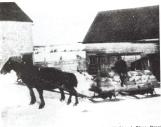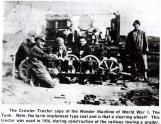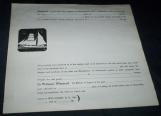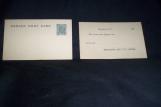2
TRANSPORTATION OF MALAGASH SALTFrom 1918 until 1927 when the railway was built to the mine, all salt was moved by horses to Malagash C. N. station.
In winter sleds were used and the spring of the year presented the greatest problem when heavy wagons sank to the axles. Some of the heavy burlap sacks carried 200 pounds of salt.
In spring when demand for fish salt was greatest, it was common for a wagon to become mired, and the sacks would be unloaded in the mud and manhandles forward and unloaded.
Salesman, Bill Fillmore, recalls that some of the sacks were a mess when the customer received them.
However, this era produced fine draft horses in Malagash, but the horse era passed when the railway was completed for the 1927 business.
Mr. Chambers purchased a Kelly truck; a war unit with chain drive and solid rubber tires. In 1928, the company purchased a 600 net ton Steamer, The Clyde Valley in England.
4
THE RAILROAD RIGHT OF WAYWhen in 1926 it was decided to build a railway from Malagash Station into the Mine with a half-mile spur to the wharf, 47 separate deeds had to be written; there were 44 property owners to deal with.
It speaks volumes for the farmers that a 50-foot right of way was purchased through their lands.
When the rails were taken up in 1959 the land was returned to the current owners.
6
RAILROADSThe railroad followed the contour of the fields and many seemingly unnecessary short radius curves plagued traffic on the salt line throughout its life. Derailments were frequent.
All track ties were two-sided, some hewn, some sawn New Brunswick cedar (an excellent wood immune to rot). Many still existed in 1948-50. A boxcar that ran on the main line for years would tip the high rail over easily on these short radius curves.
At the interchange with C. N. R., there was a double ended siding that held eleven cars. This low capacity caused the loaded cars to be pushed out and the empties were then hauled in: other wise the locomotive could not get rid of the loads and get to the front of the empties.
Steam locomotives were obtained from C. N. R. usually traded for salt. Boiler pressures were reduced from about 225 P.S.I. to 150 P.S.I. and boiler inspection was annual. The best of the steam locomotives for the job was a Mogul 2-6-0. Its low wheels enabled it to move slowly while express engines 4-4-0, with their driving wheels were indeed precarious; one puff would move them several feet.
After the de-icing salt became more important in Ontario in 1948, the rail traffic increased. Some years as high as 500 ties would be purchased. Several cars of ballast and four cars of replacement rails were purchased as well as three new box cars, with which to transport salt to the 10,000 ton wharf building 2 1/2 miles distant.
The train crew and the section crew became expert in re-railing loaded boxcars. Empty cars were simple. A steam locomotive de-railed was a real problem. The 45 ton Diesel-Electric Locomotive, purchased in 1949 was nimble compared with the 115 ton steam unit. The seven tons of coal per day at $10.00 per ton was replaced with $4.85 worth of diesel and two men manned the locomotive while the steam had three men running, and one on nights in the winter time to keep it from freezing.
Locomotive drivers included Jack Haynes and William Purdy. Maintenance of Way Foremen were Amos Latta; followed by his son Sandy Latta.
The first few trains to move salt were loaded at the Fred Myers crossing. Horses moved the bagged salt to this location while the remainder of the railroad was completed into the Mine.
8
An extract of an interview with Kenny Wilson. Kenny speaks about the shipping of the salt and the Malagash Railway.So when the railway opened in I think late 20's, 1920's or whatever, so how far did you say that track went, that actually shipped from the mine to the wharf?
No it went down to the wharf and there was what you call a 'spur' line into the wharf, so you could take salt box cars and load salt over at the wharf; but it went right out to Malagash Station and about 8 miles.
Where did they ship from there? You said it was going to Newfoundland?
Oh yes it would go to Newfoundland, yes and New England. Some of the New England states started buying salt and some of it went down by ship, and some of it went by ship to Newfoundland to.
So you had the ways of shipping then the railroad and the shipping?
Yes.
Ok. Where there any passenger trains at all used on the railway or was it just for the salt?
No just for the salt. But in the wintertime, when the roads was all blocked, messed up; back in those days you didn't have all these snow ploughs and then in the spring of the year, even when I started working in the mine, it was axel deep and for weeks you couldn't get out over it. I've seen a tractor get stuck in the middle of the road lots of times. But they used the train. If somebody had to go, we had a doctor here to, which was a mine doctor, just up the highway a little bit. So we had our own doctor. But if somebody had to go get groceries they could give the engineer the grocery list and whatever you needed, and the train would make a special trip out for a lot of people, to get their groceries.
10
THE RAILWAY TO THE WHARFThe line was 8.23 miles long without the one-half mile spur to the wharf, without the eleven car interchange track near Malagash Station and without about one mile of sidings at the Mine site.
There were two wooden trestles on the road; one over a branch of the Dewar River near Malagash Station, and one over Golding Brook near the wharf. Both were 110 feet long and 30 feet above the water at the highest point.
12
WATER TRANSPORTATIONCustomers from the Magdalen Islands, St. Pierre and Newfoundland had their schooners call at Malagash for salt. They varied in size from 60 to 200 tons and brought both bulk and salt in jute sacks. The Red River Boats moved 3,600 ton cargoes up the St. Lawrence River to paper mills, and the company's vessel, the Clyde Valley, lifted 600 tons each trip.
14
SHIPPING AN ORDERThis card was sent to the customer after their order of salt was shipped from the Malagash Salt Mine.






